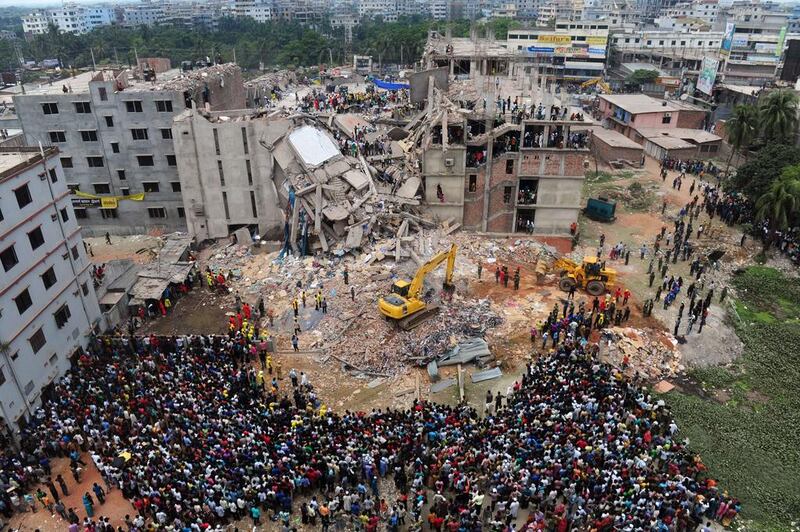SAVAR, Bangladesh // Minu Akhter has not slept properly for a year. Every time there is a noise, she wakes up fearing the roof will cave in. She cannot go to the upper floors of a building in case the staircase gives way.
Since the collapse of Rana Plaza garment factory complex just outside the Bangladeshi capital Dhaka, the 23-year-old has struggled to control her emotions. Every time she thinks of her boyfriend, tears roll down her cheeks.
When the nine-storey building failed almost 12 months ago, Ms Akhter was cutting clothing to make trousers at the doomed Phantom Apparels factory that had an order from an Italian retailer.
On that morning, April 24, 2013, her boyfriend of five years Shahin was on the other side of the aisle on the fourth floor of the complex. They smiled as they started the day’s gruelling 11-hour shift.
“Suddenly there was a loud noise and smoke shrouded our floor. All my colleagues were running for safety. In that moment I saw Shahin waiting for me so that we would run for safety together,” she said.
Almost two weeks later, as she lay in a hospital bed recovering from a fractured skull and a damaged ear, Ms Akhter heard that Shahin’s body had been pulled from the twisted wreckage.
He was one of the 1,138 people killed. Another 2,000 people were injured.
“For days I could not believe he had died. We had so many plans. We had even gone to a marriage register’s office to get married, only to decide we should wait for our families’ consent,” she said.
She was lucky to survive. Rescuers dragged her out of the rubble by tying a rope to her legs. She spent around 50 hours lying among bodies under the pan-caked floors of the building.
As Bangladesh and the world marks one year since the country’s worst industrial disaster, some things have changed for the better in the industry, but the psychological wounds inflicted on survivors remain fresh.
In a community room metres from the flattened building site where Rana Plaza once stood, Ms Akhter attends a counselling group run by therapists.
She is one among 20 victims being treated for grief and insecurity by the therapists hired by the International Labour Organisation (ILO) and British charity ActionAid.
“It’s the fourth batch of Rana Plaza victims we’re counselling. And almost every one we’ve talked to suffers from varying degree of trauma,” said lead therapist Obaidul Islam Munna.
“Most can’t sleep in the night. They can’t stand small noise. One girl even passed out the moment we used a loudspeaker. Many suffer from memory loss and smell bodies or see dead workers lying next to them.
“Some simply can’t enter a multi-storied building,” Mr Munna explained.
Outside in the garment factories, some of the cheapest and most productive in the world, the tragedy of Rana Plaza has led to a sustained focus on improving working conditions that campaigners had decried for years.
The government has hiked minimum wages for the four million mostly women workers in the sector by 77 per cent to US$68 (Dh250) a month and eased laws enabling the formation of trade unions.
It has upgraded its moribund factory inspection agency and announced the hiring of at least 200 new inspectors to try to prevent another major collapse or deadly fires which regularly kill workers.
Trade union leader Baharine Sultan said the improvements were due to intense international pressure from labour groups, the global media and western retailers that have long benefited from Bangladesh’s cheap labour.
“But we have still a long way to go. Our workers are still paid some of the lowest wages on earth. They toil 10-12 hours a day ... Union activists still face intimidation and sometimes physical assault,” he said.
Western retailers, fearing more bad publicity, have launched a massive inspection drive to weed out dangerous factories. More than a dozen plants have been shut and scores of others forced to upgrade.
They have also contributed $15 million to a $40-million Donor Trust Fund backed by the ILO to compensate the injured and the dependents of the deceased.
The first batch of 580 workers received their first cheques last month and the remaining 3,100 are set to be paid from the first anniversary of the disaster.
“The injured will be paid between $700 and $25,000 depending on the gravity of their injury,” said Roy Ramesh, local head of global labour group IndustriALL. “All of them will be fully paid by end of this year.”
The government has also paid compensation to more than 900 families of the dead workers and scores of amputated labourers.
But cases abound of victims excluded from the compensation package, others whose injuries mean they will never work again, and still more whose suffering cannot be computed in lost earnings.
Yunus Ali Sardar, 44, a poor farmer from the country’s west, was near Rana Plaza at the time of the accident and ran in to pull out trapped workers.
He saved the lives of three but before he could reach the fourth, a huge beam fell on him, leaving him paralysed in all four limbs and facing a lifetime in bed as a tetraplegic.
Because he was not a worker at the factory he is not eligible for compensation.
“Most of my savings are gone and I had to pull out my eldest daughter from school,” he said from his bed at the Centre for the Rehabilitation of the Paralysed (CRP) hospital.
For her part, Akhter is desperately trying to forget the disaster while remembering her deceased partner.
“I did not marry Shahin because I wanted to contribute to my poor family. I am grateful to Allah that I’ve survived. Now I will stand on my own,” she said.
* Agence France-Presse





